UiPath is the most popular RPA vendor; however, it has a complex RPA pricing model. We examined 10,000 different price combinations to help business and tech leaders understand UiPath’s pricing and get a high ROI RPA solution from their UiPath partnership.
You can estimate your UiPath automation costs based on the number of unattended and attended bots needed:
Since we couldn’t find a clear explanation of the pricing models, we made the following assumptions:
- Based on available information, we used a reference point of $420/month for 1 unattended bot and 2 attended bots
- The Pro plan has a limit of 5 unattended bots. Organizations requiring more must upgrade to the Enterprise plan.1
Disclaimer: This calculator extrapolates based on public data. Enterprise plan pricing may vary significantly based on volume discounts, features, and negotiated terms.
See all the new features and tools that UiPath offers, along with a full comparison of UiPath pricing plans:
What do UiPath pricing terms mean?
UiPath plans mainly differ on the number of licenses, tenants, attended and unattended bots, and the UiPath Studio. The more you need each of these, the more you will pay.
- Licenses: Permission for each tool (i.e., unattended bots, attended bots, document understanding feature, task capture, etc.) to function
- Users can view their license usage on the UiPath’s dashboard.
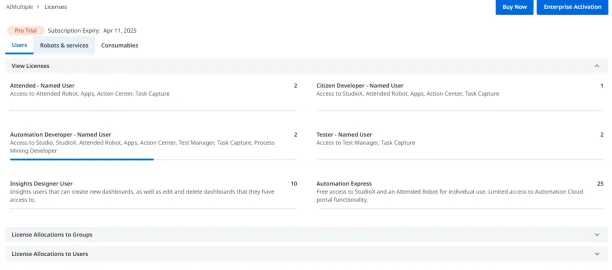
- For instance, it shows that 10.000 of the 12.000 licenses for attended bots have been allocated so far.
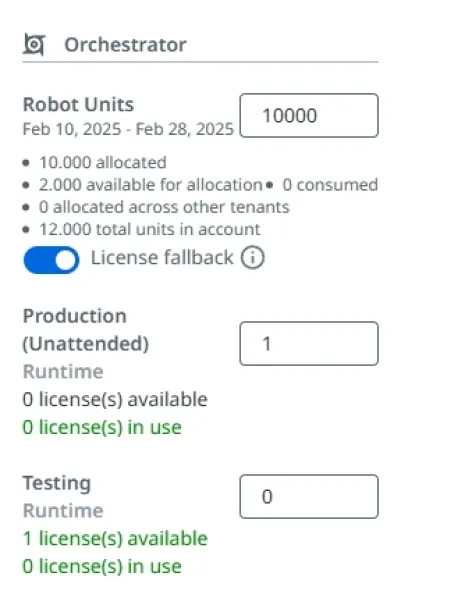
- Tenants: Compartments for storing and isolating each department’s workflows, resources, configurations, users, robots, permissions, etc.
- Attended bots: Software robots that need triggering and monitoring by a human worker
- Unattended bots: Bots that don’t need triggering and monitoring by a human-in-the-loop. Unattended robots can automatically initiate their tasks via scheduling.
- UiPath Studio: Where you create your automation workflows and manage your automation pipelines
UiPath RPA plans
The aforementioned features are packed in four cloud-based UiPath RPA platforms:
- Community version
- Free version
- Pro version
- Enterprise edition
1. UiPath Community version
In the community version of UiPath, which is designed exclusively for individual, non-commercial use, users have access to:
- 1 tenant for deploying, managing, and monitoring a single automation workflow in one environment (e.g., sales automation).
- Robot Licenses:
- Attended Robots: 2 Named User licenses (includes 50 Autopilot actions/user/year for Autopilot for everyone).
- Unattended Robots: Not included.
- Testing Robots: 1 Named User (includes unlimited Autopilot actions for Autopilot for testers).
- In-built Integration: Integration with various business applications for end-to-end orchestration.
- Task Capture: Users can map and detail steps involved in a task for better process analysis.
- Autopilot: Includes 50 Autopilot actions per user per year.
- UiPath Community: Users gain access to forums for asking questions, interacting with other users, and troubleshooting issues. Additionally, webinars and certification workshops are available for free as part of UiPath support.
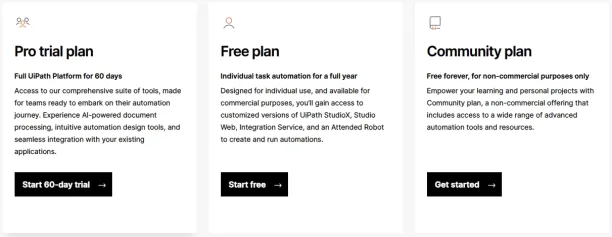
2. UiPath Free version
In the free version of UiPath, which can be used for commercial automation purposes, users have access to:
- 1 tenant + 0 attended robots licenses for deploying, managing, and monitoring a single automation workflow in one environment (i.e., sales automation)
- Robot Licenses:
- Attended Robots: 2 Named User licenses (includes 50 Autopilot actions/user/year for Autopilot for everyone).
- Unattended Robots: Not included.
- Testing Robots: 1 Named User (includes unlimited Autopilot actions for Autopilot for testers).
- In-built integration for connecting the bots with different business applications for end-to-end orchestration
- Task capture for process mapping and detailing the steps involved in a task
- Autopilot: Includes 50 Autopilot actions per user per year for Autopilot for everyone.
- UiPath Community offers forums to ask questions, interact with other UiPath users, and troubleshoot your issues. As a free feature of UiPath support, the Community also offers webinars and certification workshops.
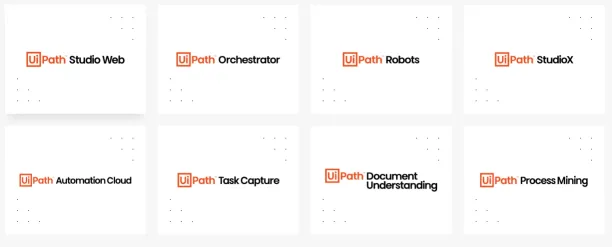
3. UiPath Pro version
In addition to task capture and process integration, UiPath’s Pro Package provides users with:
- 3 tenants + as purchased attended bots + max 5 unattended bots for deploying, managing, and monitoring automation workflows across 3 separate environments (i.e., tenants dedicated to sales, customer service, and HR automation each)
- UiPath Studio where users can create, design, and test their attended robots
- Automation Ops for defining automation boundaries and granting users varying levels of access for controlling bots
- Data Service to model, store, and manage business data within the UiPath platform so the bots can use
- Apps Center, where for low-code application development
- Action Center for interacting with the unattended robots and taking over their processes if needed
- Autopilot includes 50 Autopilot actions per user per year and unlimited Autopilot actions for developers.
- UiPath Support in English that aims to troubleshoot issues within 2 to 8 hours, depending on 2 priority levels
- Optional add-ons:
- Citizen Developer:
- Access to UiPath StudioX for building simplified automations.
- UiPath Assistant is responsible for managing and controlling self-built automation.
- Unattended Robot – Self-Hosted:
- Action Center is used to validate data or handle exceptions via the robot.
- Remote Control from a web console to manage unattended robots.
- Attended User:
- UiPath Assistant for managing and running attended automation.
- Citizen Developer:
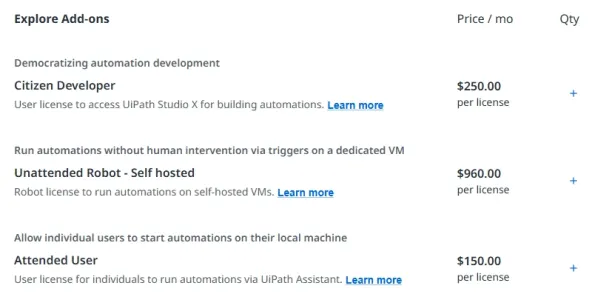
- Automation Cloud Robots offers 5,000 Robot Units/month for running automation in the Automation Cloud, which lets users run unattended workflows on the UiPath Cloud – as opposed to public cloud or on-premise – thus granting scalability.
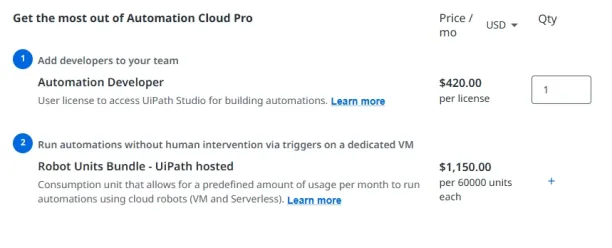
Comparison of Automation Developer & Automation Cloud Robot
| Automation Developer | Automation Cloud Robot | |
|---|---|---|
| Cost | $420.00 per user/license | $1,150.00 per 60,000 Robot Units |
| Usage | Local execution with attended robots | Cloud execution with VM or serverless robots |
| Execution Type | Runs on developer’s own machine (attended robots) | Runs in Automation Cloud (VM or serverless robots) |
| Robot Management | Developer manages and runs automations | UiPath manages the robots and infrastructure |
| Infrastructure | No cloud infrastructure involved | Cloud infrastructure provided by UiPath |
| Autonomous Execution | Requires human interaction to trigger automations | Fully autonomous execution (unattended) |
Pricing model
The Pro Plan costs $420/month or $1,570/month if purchasing the Automation Developer and Automation Cloud Robot Bundle together.
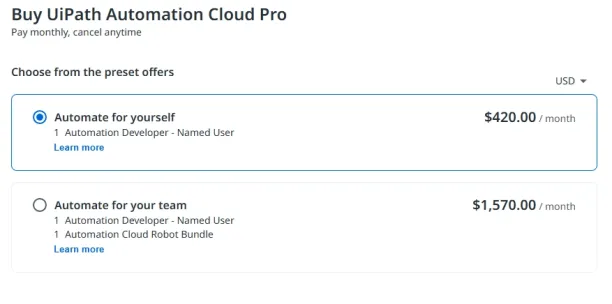
4. UiPath Enterprise edition
In addition to the features of the Pro Version, the Enterprise version of UiPath RPA gives users:
- Unlimited tenants + as purchased attended and unattended bot licenses for compartmentalizing as many automation workflows across as many departments as possible
- Process mining and task mining for x-raying all of the company’s as-is processes, giving a clear picture of all the yet-to-be-automated processes
- Document understanding for scanning documents and extracting data at scale.
- Test Manager for automating the testing of all automation pipelines in one hub with full traceability and performance report
- AI Center for improving and enhancing the ML models to create intelligent bots
- Advanced Insights for an in-depth and analytical look into the performance of automation bots
- UiPath’s Premium Support in 7 languages, offering tech support, audit reports, and root cause analysis, with a response timeline of 1 to 8 hours, depending on 3 priority levels
Pricing model of enterprise edition
Undisclosed. Per an unofficial report, it cost $87,000 in 2023.2
What do users say about the UiPath pricing model?
The consensus is that UiPath is a more expensive solution than some of its competitors, which may not be affordable for smaller businesses or those with tighter budgets. The Pro Package, priced at $420, can quickly increase with add-ons such as the Citizen Developer and Unattended Robot—Self-hosted licenses, which add flexibility but also higher costs.
This can make it challenging for businesses to determine their exact expenses up front, and users have noted the difficulty in predicting pricing based on specific company needs.
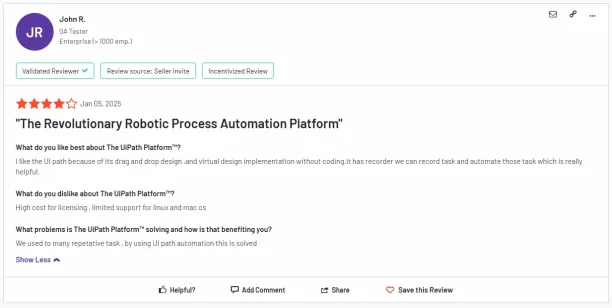
Ultimately, whether UiPath RPA is considered expensive or not is a subjective matter and may depend on individual circumstances and automation and scalability needs.
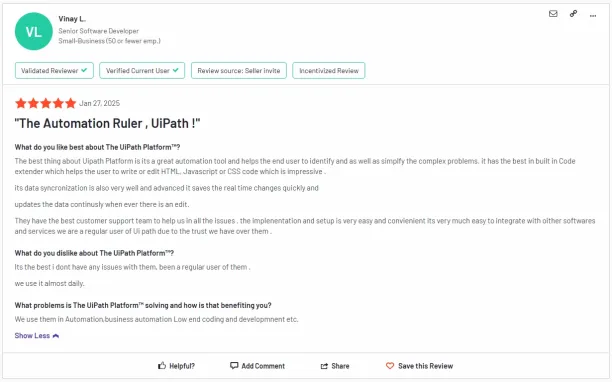
Why is UiPath’s pricing important?
UiPath is one of the biggest robotic process automation (RPA) software providers, with:
- $2B in funding
- ~10k+ customers3
- More popular than competitors

FAQ
What does the term RPA refer to?
RPA, or robotic process automation, is a technology that creates custom robots to handle routine tasks using graphical user interfaces. RPA solutions like UiPath automation lead to cost reduction, workforce augmentation, enhanced security, increased speed, and improved accuracy in business processes. It allows business users and developers to easily automate processes, enabling a significant reduction in operational cost and freeing employees to focus on more strategic services.
Who are UiPath’s alternatives?
Solutions offered by big market software vendors that operate on the same wavelength as UiPath include IBM RPA, Microsoft’s Power Automate, Automation Anywhere, and WorkFusion. Companies seeking cross-platform automation capabilities, machine learning models, or comprehensive task management often compare these vendors based on their specific automation and integration needs. The final selection depends on each organization’s goals, desired capabilities, and budget constraints, including considerations of UiPath cost.
What sets RPA apart from other automation methods for tasks?
RPA is easier to integrate with existing enterprise platforms than other automation solutions. It simplifies the automation of clearly defined, rule-based processes, and its intuitive tools, like the UiPath Studio, allow users to easily build robots and run automated tests without extensive coding. However, it may have limitations compared to advanced AI-driven or complex machine learning models in tasks requiring adaptive decision-making.
What are the differences between UiPath’s attended and unattended robots?
Attended robots assist human workers by automating routine, repetitive tasks, requiring active triggering and monitoring by the user. They’re suitable for supporting tasks carried out by business users, like sales reps performing customer interactions. Unattended bots operate autonomously, perfect for batch tasks like scheduled data extraction or invoice processing, enhancing efficiency across the enterprise.
Does UiPath offer a free trial or personal use option to explore automation opportunities?
Yes, UiPath provides both a free trial and a Community edition designed for personal use. These options allow individual users and small teams to experiment with RPA capabilities without incurring any license cost. The free versions grant access to core automation features, training resources, and community support, helping users identify suitable automation opportunities and better understand potential ROI before committing to paid subscription or advanced pricing plans like the Pro version or UiPath Enterprise.
Further reading
- 7 Steps to Select the Best RPA Tool & Vendor
- Top 4 Cost-Effective RPA Tools Under $2,000
- UiPath vs IBM RPA: Detailed Comparison of 13 Features
- Top 4 Power Automate Alternatives for Process Automation
Sources
- 1. Automation Cloud - About licensing.
- 2. “UiPath Enterprise Automation Platform Pricing.” applytosupply.digitalmarketplace.service. July 13, 2023. Retrieved on February 13, 2025.
- 3. UiPath, Inc. (PATH).

Comments
Your email address will not be published. All fields are required.